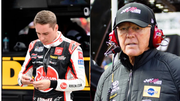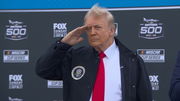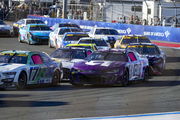
USA Today via Reuters
Feb 19, 2023; Daytona Beach, Florida, USA; NASCAR Cup Series driver Jimmie Johnson (84), driver Noah Gragson (42), driver Austin Dillon (3), driver William Byron (24), driver Zane Smith (36) and driver Harrison Burton (21) wreck during the Daytona 500 at Daytona International Speedway. Mandatory Credit: Mike Dinovo-USA TODAY Sports

USA Today via Reuters
Feb 19, 2023; Daytona Beach, Florida, USA; NASCAR Cup Series driver Jimmie Johnson (84), driver Noah Gragson (42), driver Austin Dillon (3), driver William Byron (24), driver Zane Smith (36) and driver Harrison Burton (21) wreck during the Daytona 500 at Daytona International Speedway. Mandatory Credit: Mike Dinovo-USA TODAY Sports
The Daytona International Speedway is one of the most reputable NASCAR tracks. Host to the Daytona 500 which is considered the most prestigious race on the NASCAR calendar, it has earned its place in racing history. However, it has often been the reason behind many heartbreaks as well, especially for the NASCAR community, which witnessed a polarizing revolution in the sport following the death of Dale Earnhardt in the 2001 Daytona 500.
While the Intimidator’s crash is probably the notable accident at Daytona, Danny Bagwell was involved in one of the most terrifying crashes in Daytona history in the 1999 Goody’s Dash Discount Auto Parts 200. Bagwell was lucky to have survived the crash and had the sturdy roll cage to thank for it. The vehicle underwent multiple flips on the asphalt, which dismantled the car’s peripheral components.
ADVERTISEMENT
Article continues below this ad
Danny Bagwell’s horrifying crash in 1999
The 1999 Goody’s Dash 200 was filled with wrecks. The race experienced seven cautions, and 28 cars were involved in wrecks on the day. The first caution came in the 12th lap merely 17 minutes after the start as nine cars entangled on the front stretch of the Daytona International Speedway. The event was eventually reduced to 80 laps as the authorities aimed to prevent any more life-threatening crashes in the race.
Following the first caution period, 13 cars crashed in the 20th lap, this time on the Daytona backstretch, a high-banked region. Long straights on the track give cars more freedom to exercise their raw pace, which is why it is the most dangerous track in NASCAR. In the 77th lap of the race, Danny Bagwell’s car flipped eight times on the track, triggering a 30-minute-long caution.
After the crash, Bagwell’s Ford lacked most parts, including tires, windshield, rear axle, front clip, bumpers, and the metal coating. Danny Bagwell emerged from his car in a terrified state as he removed his helmet and lay down by the destroyed vehicle.
He was immediately shifted to the Halifax Medical Center for examination, and luckily, there were no serious injuries. Bagwell was not the only driver to have visited the hospital; George Crenshaw, Danny Snell, and Scott Weaver also experienced the wrath of Daytona. Weaver and Crenshaw had to undergo surgeries due to broken legs, and Snell was scanned for neck and spine injuries.
The Daytona International Speedway has witnessed several bone-chilling crashes and eleven deaths of NASCAR drivers during races due to its dangerous conditions. While Dale Earnhardt might have been the most notable, numerous other drivers haven’t been on the kind side of history.
Read More: Geoff Bodine Reveals NASCAR’s Dale Sr Leniency Behind Drivers’ Over-Aggression With Bold Claim
Trending
Before Dale Earnhardt’s demise, Daytona International Speedway was a nightmare for NASCAR drivers
The terrifying trail of deaths at Daytona started on February 21, 1961. Habe Haberling’s Chevrolet went out of control and changed direction suddenly as the car spun before rolling terribly to the grass stretch. Haberling couldn’t survive the impact and was killed instantly as the world watched in horror. Eight years later, in 1969, Don MacTavish was racing in his Mercury Comet when he collided with a metal guard rail in a gap in the outside wall. Following the impact, Sam Sommers hit MacTavish’s car as it fell into his path, and Don MacTavish died on the spot.
On February 19 of the following year, Tab Prince and his Dodge Charger Daytona were involved in a t-bone wreck with Bill Seifert hitting the driver’s side of the car. The impact shattered Prince’s spinal cord, and he was killed instantly. One would have expected NASCAR to bring in safety changes that protected the drivers, which they did, but it wasn’t enough.
In 1972, Jimmy Crawford struck Friday Hassler’s Chevrolet as a multi-car pileup unfolded on the Daytona backstretch. Hassler’s car had hit the wall before contact with Crawford slammed him back into the wall. Hassler suffered severe neck and head injuries, which eventually resulted in his unfortunate demise. Following Hassler’s death, NASCAR races at Daytona didn’t experience any crashes resulting in fatalities until February 17, 1979.
29 years ago today, Neil Bonnett passed away from injuries suffered in a crash @ Daytona. #RIP pic.twitter.com/8vVlKyK78B
— Andrew (@Basso488) February 11, 2023
The Chevrolet Chevelle of Don Williams was locked in between a horde of cars and suffered from permanent brain damage, leaving him semi-comatose. Williams fought against death for ten years until he passed away in 1989. In 1980, Ricky Knotts suffered one of the most painful crashes in history as he went into turn one. Knotts’ Oldsmobile collided with Slick Johnson and hit the outside wall, following which he bumped into Blackie Wangerin. The car then glided across the track, crossed the grass stretch, and went into the concrete wall. This resulted in multiple head injuries, which killed Ricky Knotts on Valentine’s Eve.
Bruce Jacobi suffered a fate similar to Don Williams when his Pontiac went airborne and flipped mid-air to land on the dirt bank. Jacobi received head injuries, which put him in a coma, following which he passed away in 1987. After Jacobi’s death, Joe Young and Joe Booher lost their lives at the Daytona International Speedway in 1987 and 1993. By this time, NASCAR had understood that cars needed to be safer and the racetracks needed to be modified.
However, the changes arrived at a slower pace than necessary, and eventually, it led to three more deaths of NASCAR drivers, including Dale Earnhardt and a close friend of his. Earnhardt and Neil Bonnett were friends on and off the track. At the 1994 Daytona 500 practice race, as Bonnett’s Chevrolet Lumina went into Turn 4, it suffered a head-on collision with the wall on the upper side of the banking. He was pronounced dead on his arrival at the Halifax Medical Center.
ADVERTISEMENT
Article continues below this ad
Read the story of Don Williams, a short-tracker whose trip to Daytona ended in tragedy : https://t.co/V1iIQLgFcm pic.twitter.com/l8UwOVXSrg
— nascarman (@nascarman_rr) August 18, 2016
Merely three days after Bonnett’s death, Rodney Orr’s Ford Thunderbird similarly slid onto the banking to Bonnett. However, Orr’s car flipped and hit the wall by the roof, and his head suffered a massive impact, which killed Orr instantly. NASCAR’s relaxed approach to driver safety ended in 2001 when the sport lost its most beloved driver and a 7-time Cup Series champion.
ADVERTISEMENT
Article continues below this ad
Since Earnhardt’s death, NASCAR has been exemplary in motorsports regarding protecting drivers. No lives have been lost in a NASCAR race since the Intimidator’s demise. Looking at the long list of unfortunate tragedies at Daytona, one cannot help but wonder if NASCAR could have helped prevent these deaths.
Watch This Story: Fans rally behind Kevin Harvick as he slaps back at “smart a**” comment against his NASCAR career
ADVERTISEMENT
ADVERTISEMENT
ADVERTISEMENT
ADVERTISEMENT






